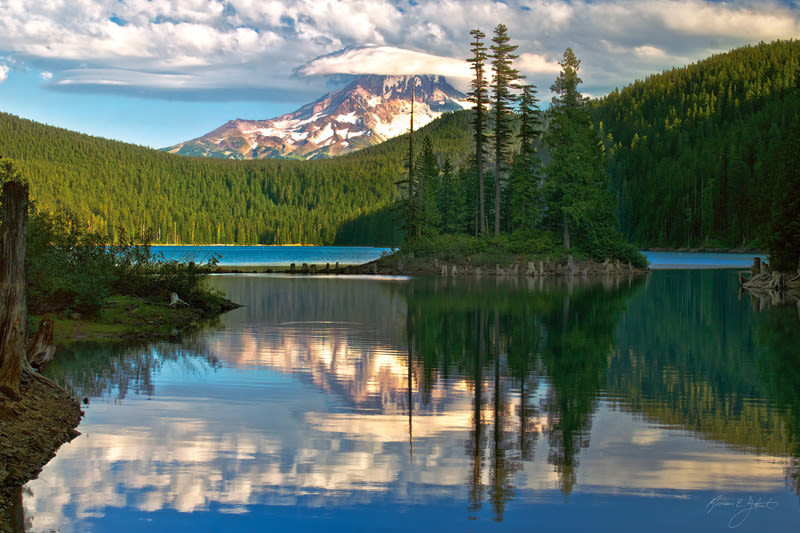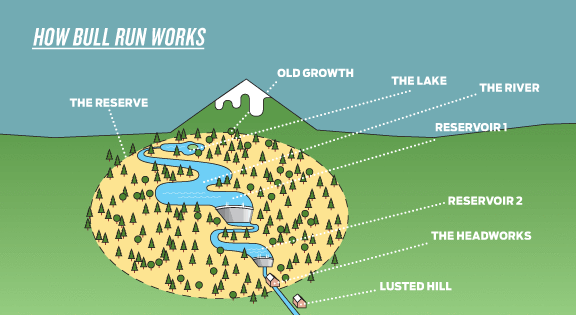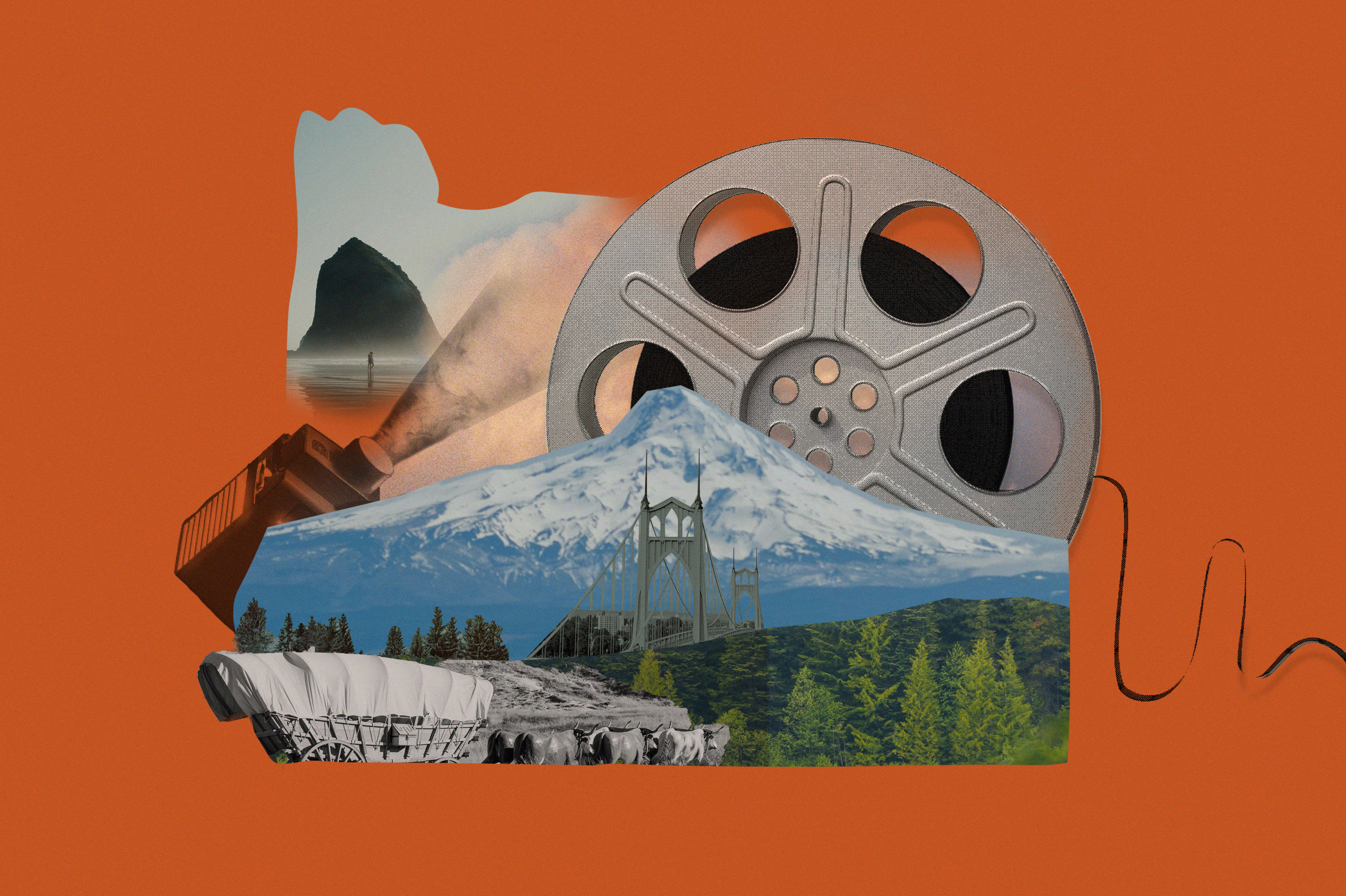Liquid Assets

The best swimming hole you’ll never see: Bull Run
FOR AROUND 900,000 PORTLANDERS, most sips of water, morning showers, and cocktail ice cubes originate in a landscape stunning enough to be a national park, if only Teddy Roosevelt had gotten there before the plumbers.
In the 1880s, Portland’s unironically bearded leaders needed to replace dirty, unreliable water sources, so they chose a pristine lake and river with headwaters 35 miles from the growing city. They hired an ingenious engineer (and ex-Confederate officer) named Isaac Smith to bridge the gap. Given the conditions of the time, they might as well have ordered a lunar expedition. Smith spent months battling the Mount Hood wilderness to survey a path that would allow gravity to propel water to Portland. Then he and a largely Italian labor force built that system, which first flowed in 1895.
“It’s hard to appreciate now just how far 35 miles was then,” says Casey Short, author of Water: Portland’s Precious Resource. “The engineers I talk to today still marvel at what Smith accomplished.”
His exploit forever bound Portlanders to a place most will never see: the Bull Run watershed.
Today, Bull Run supplies more than 95 percent of the city’s drinking water through a majestic fusion of primordial nature, complicated law, and technology old and new. Thanks to an act of Congress, the reservation surrounding Bull Run, guarded by trespassing notices and targeted patrols, is arguably one of the world’s best-protected urban water sources. It’s also both a de facto nature reserve—home to some 250 species and 750-year-old trees—and Portland’s oldest public-works project, where scenic glory and prosaic machinery mingle. Seventeen billion gallons of water lap against two reservoirs’ forested shorelines, while island-like concrete towers suck in frigid water and funnel it to the city through three giant conduits.
“I think Portlanders imagine the Bull Run as a pristine, untouched place,” says Edward Campbell, the Water Bureau official in charge of protecting the watershed. “It’s anything but that. We’re running several major industrial operations up here.” On a recent visit, for example, hydraulic equipment hammered away, driving pilings into the lower reservoir’s bottom for a temporary platform that underwater construction specialists will use to dive over 120 feet deep as they modify one intake tower. This $38 million project will channel colder water downstream to help endangered salmon swimming in the Bull Run River—just one of 49 such steps painstakingly negotiated, over a period of a decade or so, between the city and federal officials.
Bull Run’s intensely engineered landscape emerged from an era when people thought (and built) big. Today’s complications, like salmon recovery, reconcile that imperious older attitude with modern concerns. Last year, the city convinced higher authorities to suspend national rules that would have required a new treatment plant aimed at cryptosporidium, an intestinal bug almost unknown in Bull Run. Meanwhile, Portland and the US Forest Service—which once logged Bull Run and still owns most of it—must collaborate to guard against fire and intruders.
The future could be even more intricate. Global climate change models are too large-scale to predict what will happen, according to Lorna Stickel, the Water Bureau’s main climate analyst. “For a small, specific place like Bull Run,” she says, “the potential outcomes are all over the map.” In a hotter Oregon, it’s likely (but not certain) that more rain will fall in winter, less in spring and summer. The city may draw more water from Bull Run’s less charismatic (but crucial) backup, groundwater from the Columbia’s south shore.
The more hopeful prospect is that, thanks to a 19th-century vision, 21st-century Portland will be water-rich. (So far, about 20 percent of Bull Run’s total supply meets the city’s demands.) With much of the world facing acute shortage, Bull Run could endure as an example of how urban civilization can solve its oldest problem and husband its most essential resource.
“Find water and roll it downhill,” says Dick Robbins, a Water Bureau veteran. “The Romans were doing this.” The Romans, however, often struggled to keep enough water flowing to their Eternal City. Even Caesar didn’t have Bull Run.
HOW BULL RUN WORKS

Image: Michael Novak
THE RESERVE This federally protected zone on Mount Hood’s western flank receives some of Oregon’s heaviest rainfall (170 inches per year in some places) and is off-limits to almost everyone. The US Forest Service owns most of the land; the city’s Water Bureau manages what’s most important.
OLD GROWTH The Forest Service once logged Bull Run, but the last timber harvest occurred in 1993. A fire in 1943 burned almost all of the area, but two small, unburned patches are home to 750-year-old trees.
THE LAKE Filled mostly by rainfall, Bull Run Lake is about 10 feet higher now than it was before Portlanders altered it to serve as the origin point of the city’s drinking-water system.
THE RIVER The lake feeds the Bull Run River—the water soaks through a natural filtration system of soil and rock before reappearing aboveground.
RESERVOIR 1 The Bull Run River and various streams and creeks fill this 10-billion-gallon trough, which powers a 24-megawatt hydroelectric dam.
RESERVOIR 2 The city’s water supply is drawn from this 7-billion-gallon man-made lake, through intake towers that can suck as much as 182 million gallons out of the reservoir on a summer day.
THE HEADWORKS Engineers treat outgoing water with chlorine to kill bacteria and viruses; the water then travels six miles through conduit pipes, driven entirely by gravity.
LUSTED HILL Ammonia is added to the water at this facility; it bonds chemically with the chlorine, giving it a longer-lasting disinfectant power (and meaning less is needed overall, preserving Portland water’s relatively chemical-free taste).




